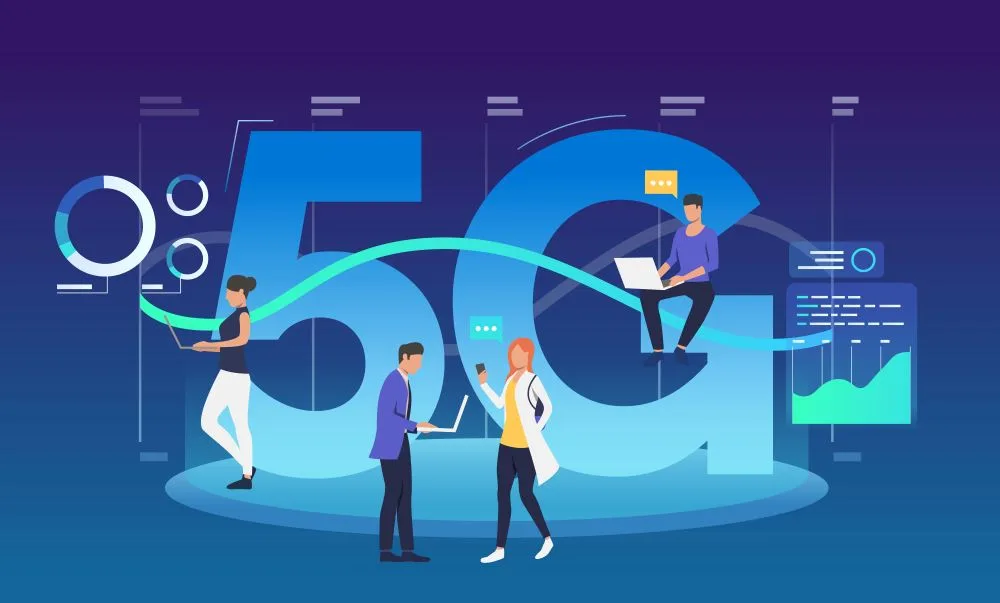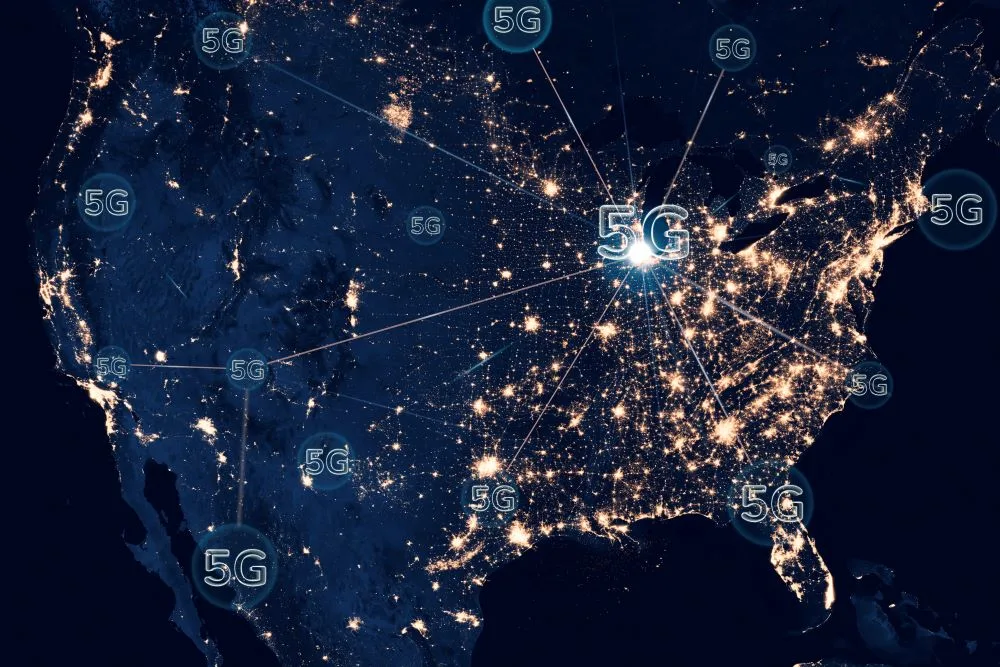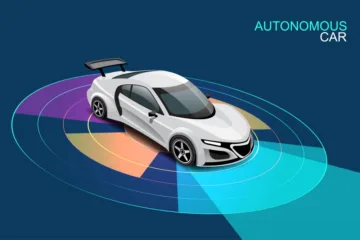Communication and network are at their peaks in recent times. 5G is the fifth generation of high-speed technology that surpasses the influences of 3G and 4G networks. The expansion of 5G will reach new heights of communication and enhance broadband speed at an elevated rate. It is expected to be the communication hub that connects virtual reality, autonomous vehicles, IoT, and many other emerging trends.
5G networks will operate in several different frequency bands, out of which the lower frequencies are currently proposed in the initial phase. For previous generations, ultra-high frequencies (UHF) and frequencies below 1 GHz have been already used. The technology evolution also plans to use much higher radio frequencies (RF) in later stages.
What is 5G technology?
As previously stated, the fifth-generation technology is a breakthrough innovation for the global network. Starting at the end of 2018, it has gained immense attention worldwide. With a peak speed of 20 Gbps, it has exceeded the speed limit of 1Gbps offered by 4G. It has the potential to improve digital applications like gaming, video conferencing, and autonomous cars by delivering lower latency.

Virtualized 5G networks are software-driven and can leverage cloud technology. 5G’s seamless open roaming capabilities will make cellular and Wi-Fi access easier. While moving between outdoor connections and wireless networks within buildings, mobile users can stay connected without reauthentication or user interruption. These networks will use a dense, distributed-access architecture to move data processing closer to the user and edge, allowing users to process data faster.
There are some features that underpin 5G technology:
- Latency of 1 millisecond
- Practical speed of 10 Gbps
- 100% coverage
- Almost 100% availability
- A maximum of 100x number of coupled devices per unit area (compared with 4G LTE)
Benefits of 5G
- High speed: A theoretical speed of more than 20 Gbps and a practical speed of at least 10 Gbps is the main advantage of this network. Users can download, access, and surf a wide variety of files, videos, programs, etc., in just a few seconds. Due to the enormous use of the cloud, mobile phones, laptops, etc., will not entirely rely on their internal memory. This is crucial for businesses and organizations to perform advanced communication.
Learn about different kinds of business at 10 types of common business forms in the world.
- It is more secure and faster. On the go, you can quickly connect to the internet when you need to. Stop worrying about hackers and snoopers and start your own hotspot.
- Low latency: We define latency as the time between placing an order on our device and executing it. In 5G, the latency will be ten times lower than in 4G, allowing remote actions to be achieved in real-time. Due to this, it is possible to control remote operations, machines, and systems. Latest techniques like IoT, augmented reality, automation, etc., are worth this.
- Less congestion due to more bandwidth and better speed.
How does 5G work?
5G signals transfer through many small cell stations positioned at places such as building roofs or light towers. The usage of multiple small stations is critical because the millimeter wave (mmWave) spectrum can only travel over short distances. In the case of 5G, a band of 30-300 GHz (gigahertz) is subject to interference from obstacles like trees or buildings.
Past network generations have utilized lower frequency bands. Industry experts are considering lower frequency bands for 5G to overcome the issues linked to the distance and interference with mm-Wave. It will be convenient for network operators as they will use the existing spectrum to create new networks. These bands are composed of low-band (600-700 MHz) and mid-band (2.5-3.5 GHz) spectrums.
Another method is to place multiple nodes around each block in a populated area, allowing 5G-enabled devices to utilize an Air interface, switching from node to node simultaneously while maintaining MM wave speeds.
A combination of low, mid, and high spectrum bands can also be feasible. This can cover high as well as low dense areas. One 5G-enabled device can stay connected to a low-band 5G node for hundreds of miles. Implementing all three bands will result in blanket coverage while providing the highest speed in the most heavily populated areas.
The transition from 1G to 5G
The evolution of network generations has started from 1G and reached 5G.

First-generation (1G)
1 G standardization took place in 1981 for the sake of voice communication. It was capable of handling data at a rate of 2.4 kbps. A few popular technologies were the Total Access Communication System (TACS), Nordic Mobile Phone System (NMTS), etc. 1G faced many issues due to less security, poor signal quality, low capacity, and unreliability.
Second generation (2G)
In 1990, 2G was formulated. It was capable of handling data transfer up to 64kbps. Some renowned 2D techniques were Code division multiple access (CDMA), Global system for mobile communication, etc. This network has allowed sending of text messages, MMS, and pictures. Safe point-to-point communication was possible at that time. However, some difficulties were associated, such as the limited capacity of cells, high latency, slow data speed, etc.
Extension to second-generation (2.5G)
2.5 G has offered a data transfer rate of up to 144 kbps. This generation has introduced a packet-based switching method called GPRS (General Packet Radio Services). Better communication was established with the combination of packet switching and circuit switching. As for 2.5G-access technologies, the most popular ones were GPRS, Code Division Multiple Access-2000 (CDMA2000), and Enhanced Data Rate for GSM Evolution (EDGE).
Third-generation (3G)
3G has enabled high-speed data transfer up to 2Mbps. Specific applications were developed to allow users to take advantage of 3G smartphone capabilities by handling video calls, online games, email services, and social media services such as Facebook and Orkut. Wideband Code Division Multiple Access (WCDMA), CDMA2000, and Universal Mobile Telecommunications Systems (UMTS) were a few of the most widely used 3G technologies.
To understand crucial aspects of gaming, read our article 8 interesting facts about the gaming industry.
Fourth generation (4G)
4G came into practice in 2010 and has the ability to manage data transfer up to 300 Mbps. This gave access to the high-definition (HD) world. VoLTE (Voice over LTE networks) is by far the most popular technology for 4G access. It is also more expensive in terms of hardware and implementation than 3G. 4G technology requires high-end multifunctional devices for communication. Most 3G and 4G systems focus on delivering content to mobile devices rather than on efficient delivery.
With 5G wireless networks, billions of devices can be served with minimal latency.
The global position of 5G
It is predicted that by 2025, 5G is likely to occupy one-third of the global population. It will be the catalyst for driving various innovative techniques like IoT, AI, businesses, telecom, automation, etc. Currently, many carriers are working on establishing a 5G network, including AT&T, Sprint, and Verizon. Recent advances involve the following technologies:
- NOMA (Non-Orthogonal Multiple Access)
- MIMO (Multiple-input-multiple-out)
- Millimeter-wave
- Machine learning techniques
- IoT-based approaches
A thorough understanding of such state-of-the-art technologies requires a deep understanding of the subject matter.
5G has enabled progressive development in healthcare, energy infrastructure, framing, smart cities, and many other applications. Researchers are identifying the weak areas and addressing the concerns associated with this network. The future is innovation, and we will continue to push technology boundaries to serve new market requirements and offer future services that will be developed in the coming years. Approximately ten years after 5G, we will experience the next technological leap. Meanwhile, we are conducting fundamental research to propel the industry toward new technological breakthroughs.




[…] have a vast scope for opportunities to profit. Chip demand will surge in the near future due to 5G, AI, cloud computing, electric vehicles, and the Internet of […]
[…] high-speed, low latency, less congestion, and tight security, the 5G network is booming. This extremely reliable network will promote industrial control, cyber health, smart […]
[…] people from all age groups. As a child, playing Supermario was such a craze. With the launch of 5G, cloud gaming is expected to reach new heights all over the globe. Let’s find out some […]
[…] is an essential part of linking devices with people in smart cities. It may comprise services like 5G, blockchain, […]